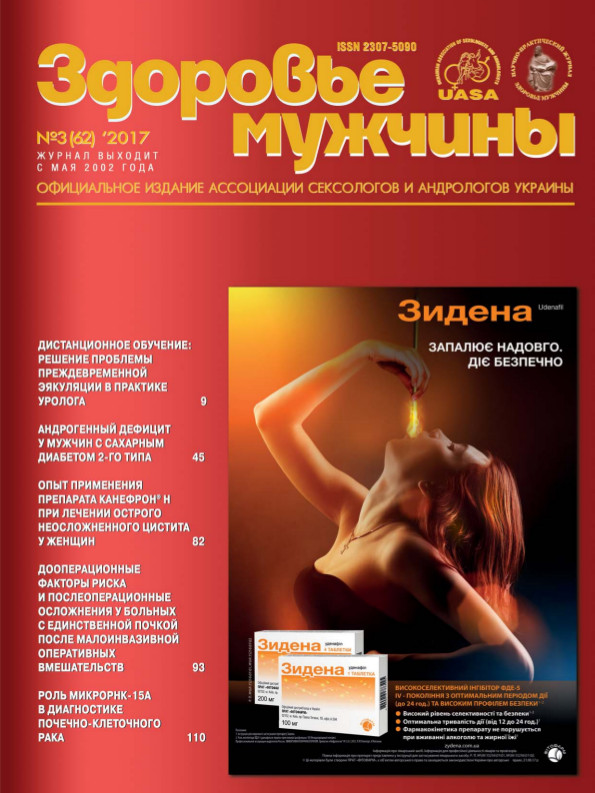Preoperative risk factors and postoperative complications in patients with single kidney after minor invasive surgical interventions
##plugins.themes.bootstrap3.article.main##
Abstract
The objective: the purpose of the work was to determine the risk factors for the occurrence of postoperative complications in patients with ureterolithiasis of a single kidney (SK) after minor invasive surgical interventions.
Patients and methods. 254 patients with ureterolithiasis participated in the study, of which 141 were cohorts of persons with SK (groups I, II and III), and others – a cohort of persons with two kidneys. According to the gender distribution, the male sex was 152 (59.8%), female – 102 (40.2%) cases, and the average age was 44,7±2,1 years (female – 42,3±1,5 years, male – 39,7±1,4 years). Formation of groups was carried out on the basis of rendering of operational help: I group – treatment of ureterolithiasis SK by the method of TUCL – (n=34); Group II – treatment of Ureterolithiasis in SK by ESWL method (n=76); Group III – treatment of ureterolithiasis in SK by means of ureterolithotomy (n=31); IV group – treatment of ureterolithiasis by the TUCL method (n=42); V group – treatment of ureterolithiasis by ESWL (n=38); VI group – treatment of ureterolithiasis by means of ureterolithotomy (n=33).
Results. Preoperative risks of the occurrence of postoperative complications in patients with Ureterolithiasis of the SK are presented: by the fact of the presence of SK; the fact of a high level of cardiovascular pathology and metabolic syndrome, 1,5 times more than in the case of persons with two kidneys; the fact of lowering the average indicators of glomerular filtration rate, which is 1,8 times lower than that of those with dummy kidneys. Levels of risk of development of postoperative complications in the cohorts of persons with two kidneys (23,3%) and SK (33,3%) differ significantly in 1,4 times (p<0,05), which indicates a single kidney as an independent a powerful pathological factor.
Conclusion. Performing minor invasive interventions in patients With ureterolithiasis, SK is a promising area that minimizes operational trauma, as well as creates conditions for the reduction of postoperative calculus relapse levels.
##plugins.themes.bootstrap3.article.details##

This work is licensed under a Creative Commons Attribution 4.0 International License.
Authors retain the copyright and grant the journal the first publication of original scientific articles under the Creative Commons Attribution 4.0 International License, which allows others to distribute work with acknowledgment of authorship and first publication in this journal.
References
Attanasio M. The genetic components of idiopathic nephrolithiasis // Pediatr. Nephrol. – 2011. – No 26 (3). – P. 337–346.
Аляев Ю.М. Мочекаменная болезнь: современные методы диагностки и лечения: Руководство. – М.: ГЭОТАР-Медиа; 2010. – 224 с.
Аляев Ю.М., Саенко В.С., Песегов С.В. Роль 3d-компьютерного моделирования в улучшении результатов лечения коралловидного нефролитиаза // Урология. – 2015. – No 4. – С. 7–10.
Аполихин О.И., Сивков А.В., Солнцева Т.В. Эпидемиология МКБ в различных регионах РФ по данным официальной статистики // Саратов. науч.-медиц. журн. – 2011. – No 7. – С. 120.
American Urological Association Guideline on the Management of Staghorn Calculi. 2005. – 124 р.
Brenner Z.Z., Winchester J.F., Salman H., Bergman M. Nephrolithiasis: evaluation and management // South. Med. J. – 2011. – Vol. 104 (2). – P. 133–139.
Дзюрак В.С. Сечокам’яна хвороба / В.С. Дзюрак, С.О. Возіанов // Мистецтво лікування. – 2004. – No 7. – С. 72–76.
Люлько О.В. Наукові основи руйнування сечових каменів як біологічних об’єктів / О.В. Люлько, С.І. Бараннік, Ю.М. Постолов, А.М. Зорін // Урологія. – 2005. – No 2. – С. 12–22.





